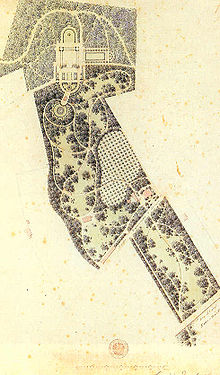Pfingstberg (Potsdam)
| Pentecost Mountain | ||
|---|---|---|
|
View from the Belvedere on the Pfingstberg |
||
| height | 76 m above sea level NHN | |
| location | Potsdam ( Brandenburg , Germany ) | |
| Coordinates | 52 ° 25 '7 " N , 13 ° 3' 32" E | |
|
|
||

At 76 meters above sea level, the Pfingstberg is one of the highest elevations in Potsdam and is best known for its Belvedere , which Friedrich Wilhelm IV had built by the architects Ludwig Persius , Friedrich August Stüler and Ludwig Ferdinand Hesse based on Italian models by 1863 . The park-like garden was designed according to plans by Peter Joseph Lenné .
On the Pfingstberg, next to the Belvedere, there is also the Pomona Temple (1801), the first building by Karl Friedrich Schinkel, who was only nineteen at the time .
After the Second World War , the castle fell into ruin and the park became increasingly overgrown. An association has been trying to restore the facility since the late 1980s. With the support of the Prussian Palaces and Gardens Foundation Berlin-Brandenburg and generous donations, the park and palace were largely restored and reconstructed by 2003.
Naming
In a map from 1683 there is still the name Eichberg . This was an urban forest from which the population was allowed to take wood for house construction free of charge. After the construction of the Jewish cemetery on the southern slope, the Eichberg was renamed Judenberg in 1743 .
The third name was given after King Friedrich Wilhelm III bought a plot of land with a pavilion, the Pomona Temple . in 1817. From then on, the hill was called Pfingstberg today .
The site belonged to the Privy Councilor Carl Ludwig von Oesfeld , where Queen Luise is said to have dined at Whitsun 1804. After the pleasant stay on the vineyard, it is reported that the Queen proposed the renaming of the mountain. Friedrich Wilhelm III. is said to have changed the name in 1817 - in memory of his wife who died in 1810. A second version is that a visit by the king to the hill at Pentecost in 1817 was the reason for the change.

